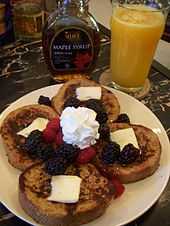French toast
| French toast | |
|---|---|
|
French toast served at a restaurant | |
| Serving temperature | Hot, with toppings |
| Main ingredients | Bread, eggs |
|
| |
French toast, also known as eggy bread,[1] gypsy toast,[2] German toast,[3][4] or Spanish toast[4] is a dish of bread soaked in beaten eggs and then fried.
History and names
The earliest known reference to French toast is in the Apicius, a collection of Latin recipes dating to the 4th or 5th century; the recipe mentions soaking in milk, but not egg, and gives it no special name, just aliter dulcia "another sweet dish".[5]
Under the names suppe dorate, soupys yn dorye, tostées dorées, and payn purdyeu, the dish was widely known in medieval Europe. For example, Martino da Como offers a recipe. French toast was often served with game birds and meats. The word "soup" in these names refers to bread soaked in a liquid, a sop.[6]
A fourteenth-century German recipe attributes the name Arme Ritter ("poor knights"),[7][4] a name also used in the Scandinavian languages. Also in the fourteenth century, Taillevent presented a recipe for "tostées dorées".[8]
There are fifteenth-century English recipes for pain perdu[9] (French for "lost [or wasted] bread", suggesting that the dish is a use for bread which has gone stale).[10][4]
An Austrian and Bavarian term is "Pavese", perhaps related to a kind of wooden shield or to zuppa pavese, both referring to Pavia, Italy.
Preparation and serving

Slices of bread are soaked or dipped in a mixture of beaten eggs, often with milk or cream. The slices of egg-coated bread are then fried on both sides until they are browned and cooked through. Day-old bread is often recommended by chefs because the stale bread will soak up more egg mixture without falling apart.[11]
The cooked slices can be covered with sweet toppings such as jam, honey, fruit[12] or maple syrup, or given a savory topping such as bacon, cheese or cold-cooked meats.
Variations

In French speaking regions, French toast is referred to as pain perdu, meaning "lost bread" in French. It is referred to as "lost bread" because it is a way to reclaim stale or otherwise "lost" bread. The hard bread is softened by dipping in a mixture of milk and eggs, and then fried. The bread is sliced on a bias and dipped into a mixture of egg, milk, sugar, cinnamon and vanilla. The slices are pan-fried in butter and traditionally dusted with powdered sugar and served with jam or syrup on the side. Pain perdu may be eaten as a dessert, a breakfast, as well as an afternoon tea snack ("goûter").[13]
Hong Kong–style French toast is listed at number 38 on the World's 50 most delicious foods compiled by CNN Go in 2011.[14] It is made by deep-frying stacked sliced bread dipped in beaten egg or soy, served with a slab of butter and topped with golden syrup, or sometimes honey. Two slices are normally used and a sweet filling is usually added.[15]
Torrija is a similar recipe traditionally prepared in Spain for Lent and Holy Week.
See also
References
- ↑ Beckett, Fiona (18 September 2010). "Student cookbook: French toast (aka eggy bread)". The Guardian. Retrieved 13 December 2012.
- ↑ Mille (24 February 2002). "Gypsy Toast". food.com. Retrieved 19 January 2015.
- ↑ Farmer, Fannie Merritt (1918). The Boston Cooking-School Cook Book. Boston: Little, Brown; republished at Bartleby.com, 2000. Retrieved 6 April 2015.
- ↑ 4.0 4.1 4.2 4.3 Koerner, Brendan. "Is French Toast Really French?". Slate.com. Retrieved 6 April 2015.
- ↑ Joseph Dommers Vehling, trans., Apicius: Cookery and Dining in Imperial Rome, Book VII, chapter 13, recipe 296 full text at Gutenberg
- ↑ Odile Redon, et al., The Medieval Kitchen: Recipes from France and Italy, 2000, p. 207f
- ↑ Grimm, Jacob and Wilhelm. Deutsches Wörterbuch, quoting from the Buch von guter Spyse.
- ↑ Pichon, Jérôme; Vicaire, Georges (1892). Le Viandier de Guillaume Tirel dit Taillevent. p. 262.
- ↑ Austin, T. Two 15th-century Cookery-books, 1888, quoting a 1450 recipe, quoted in the Oxford English Dictionary
- ↑ Davidson, Alan; Jaine, Tom (2006). The Oxford Companion to Food. Oxford University Press. p. 102. ISBN 0-19-280681-5.
- ↑ Alton, Brown. "French Toast-Food Network".
- ↑ "French Toast Toppings – Unique French Toast Recipes". Good Housekeeping. Retrieved 19 January 2015.
- ↑ (French) Wikipedia article about the pain perdu
- ↑ CNN Go World's 50 most delicious foods 21 July 2011. Retrieved 2011-10-11
- ↑ "40 Hong Kong foods we can't live without", CNN Go, 13 July 2011. Retrieved 2011-10-09
Further reading
- Claiborne, Craig (1985). Craig Claiborne's The New York Times Food Encyclopedia. New York: Times Books. ISBN 0-8129-1271-3.
- Farmer, Fannie (1918). The Boston Cooking-School Cook Book. Boston: Little, Brown and Co.
- Mariani, John F. (1999). The Encyclopedia of American Food and Drink. New York: Lebhar-Friedman. ISBN 0-86730-784-6.
- Redon, Odilie (1998). The Medieval Kitchen: Recipes from France and Italy. Chicago: Univ. Chicago Press. ISBN 0-226-70684-2.
External links
| Wikimedia Commons has media related to French toast. |
| Wikibooks Cookbook has a recipe/module on |
| Wikiquote has quotations related to: French toast |
| ||||||||||||||||||||||||||||||||||||||||||
